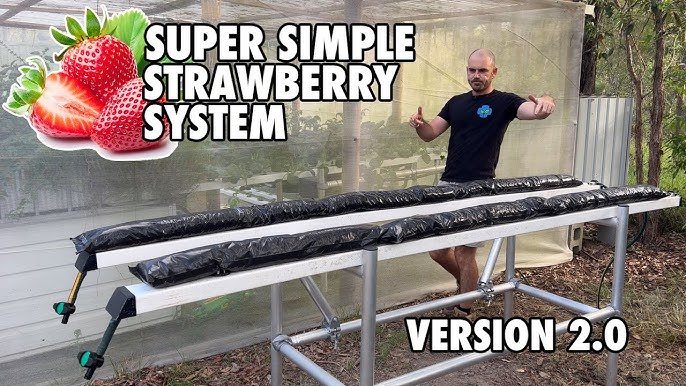Growing hydroponic strawberries is an innovative and rewarding way to enjoy fresh, flavorful berries year-round, right from the comfort of home. Hydroponics—growing plants without soil—offers greater control over the environment and nutrients, higher yields, and fewer pests or diseases compared to traditional gardening. With the right know-how, anyone—from beginners to green-thumbed enthusiasts—can successfully set up a strawberry hydroponic system and harvest sweet berries even in compact indoor spaces. Below is a thorough, step-by-step guide to ensure you get started on the right foot.
What Are Hydroponic Strawberries?
Hydroponic strawberries are strawberries grown in a soil-free environment where nutrient-rich solutions deliver everything the plant needs directly to its roots. Rooted in mediums such as coco coir, perlite, or expanded clay, these plants thrive with less water and fewer chemicals compared to soil-based cultivation, making them a sustainable and eco-friendly choice.
Benefits of Hydroponic Strawberry Growing
-
Year-Round Harvests: Control temperature, humidity, and light to enjoy strawberries regardless of season.
-
Clean, Pest-Free Berries: No mud, fewer bugs, and virtually no weeding.
-
Efficient Space Use: Vertical or stacked systems maximize yield per square foot, ideal for balconies, kitchens, or small gardens.
-
Water Savings: Uses up to 90% less water compared to soil-based gardening.
Choosing the Right Strawberry Hydroponic System
There are several types of systems suitable for hydroponic strawberry plants. Consider your space, budget, and technical comfort when making a choice:
-
Nutrient Film Technique (NFT): Thin streams of nutrient solution flow over the roots in angled channels. This method is common for strawberries due to its simplicity and efficiency.
-
Deep Water Culture (DWC): Plants are suspended above a deep reservoir of aerated, nutrient-rich water.
-
Drip Systems: Nutrients are delivered via a tube to each plant, excellent for growing in media like coco coir or perlite.
-
Ebb and Flow (Flood and Drain): Plant sites are periodically flooded with solution before draining away—well-suited for larger home systems.
For beginners, an NFT system is often recommended because it is modular, energy efficient, and can be expanded easily as your crop grows.
What You Need to Build a Home System
Basic Components:
-
Channels or tubes for plant support (PVC pipes, gutters, or commercial NFT channels)
-
Reservoir (clean, food-safe storage bin or tote)
-
Submersible water pump
-
Air pump and air stone (for DWC or to oxygenate reservoir)
-
Net pots or mesh baskets
-
Growing medium (e.g., coco coir, perlite, or clay pebbles)
-
Tubing and connectors
-
pH and EC meters
-
Nutrient solution formulated for strawberries
-
Grow lights (for indoor or short-day growing)
-
Healthy hydroponic strawberry plants or rooted runners
Step-by-Step: Building Your Strawberry Hydroponic System
1. Plan Your Layout
Assess your available space (indoors or outdoors). Mark where your plant channels, reservoir, and pumps will go. Vertical towers suit tight spaces, while horizontal channels are best for bigger areas.
2. Assemble the Frame and Channels
Use lightweight materials (PVC, metal, or recycled containers) to build a support structure. Drill evenly spaced holes for net pots, ensuring enough room for strawberries to grow.
3. Install the Reservoir and Pump
Place your water reservoir at the base for easy access. Fit and connect your pump to push nutrient solution up and through the plant channels. Use a timer to automate cycles if using an Ebb and Flow system.
4. Add Growing Media and Plant Strawberry Transplants
Gently nestle strawberry transplants—or bare-root runners—into net pots, surrounding roots with coco coir or similar medium for moisture retention and aeration.
5. Set Up Tubing and Nutrient Flow
Connect tubing to channel inlets and outlets. Position return tubing so surplus solution drains freely back into the reservoir. Double-check for leaks and stable connections.
6. Mix and Monitor Nutrient Solution
Mix nutrients according to manufacturer’s instructions, aiming for a balanced blend containing nitrogen, potassium, phosphorus, and trace elements. Adjust pH to 5.8–6.5 and monitor EC (electrical conductivity) for optimal plant uptake.
7. Lighting and Environmental Controls
For indoor systems, install LED grow lights (set 12–16 hours/day) and monitor room temperature (ideally 65–75°F / 18–24°C) and humidity (50–75%). Ensure good air circulation and install a fan in enclosed spaces.
Best Strawberry Varieties for Hydroponics
The following varieties are highly recommended for hydroponic strawberries due to their compact growth and reliable fruiting:
-
Albion: Sweet, large berries, day-neutral.
-
Seascape: Popular for consistent yields.
-
Aromas: Known for their strong fragrance.
-
Evie-2: Disease resistant and vigorous.
Many specialty nurseries offer certified disease-free hydroponic strawberry plants; choose runner types or plugs suited to your system.
Pollination and Maintenance
Strawberries require gentle pollination if grown indoors. Shake plants lightly during flowering, or use a soft paintbrush to move pollen between blooms. Regularly inspect roots for rot, trim dead leaves, and ensure nutrient solutions are fresh and balanced.
Keep channels clean and occasionally flush the system with plain water to prevent salt buildup. Replace the nutrient solution every 2–3 weeks and check equipment for wear.
Troubleshooting and Tips
-
Yellowing leaves: Usually a pH imbalance—test and adjust nutrient pH as needed.
-
Wilting or dry plants: Check that water and nutrient solution is circulating, with no blockages or pump issues.
-
Faded fruits: Not enough light or improper pollination—adjust accordingly.
-
Pest outbreaks (rare): Use sticky traps or insecticidal soap; however, hydroponic systems are typically less prone to infestation.
Harvesting Your Hydroponic Strawberries
Fruits are ready to pick when fully red and fragrant. Harvest by pinching the stem just above the berry to avoid bruising. With proper care, hydroponic strawberry systems can yield multiple flushes annually, making the most of your effort and investment.
High Authority Resource
For deeper technical insights and the latest research on hydroponics, see this comprehensive scientific review published in the prestigious National Institutes of Health database:
Hydroponics: current trends in sustainable crop production (PMC/NLM). This review offers a scholarly overview of hydroponic systems, best practices, and the science behind this fast-evolving field.
Read More: Step-by-Step Guide to Planting Hydroponic Strawberry Plants
Conclusion
Building a hydroponic strawberry system at home brings the joy of fresh berries to your kitchen, conserves resources, and lets gardeners experiment with the future of sustainable food production. With a thoughtful setup and attention to detail, anyone can cultivate delicious, clean, and eco-friendly strawberries indoors or out.









